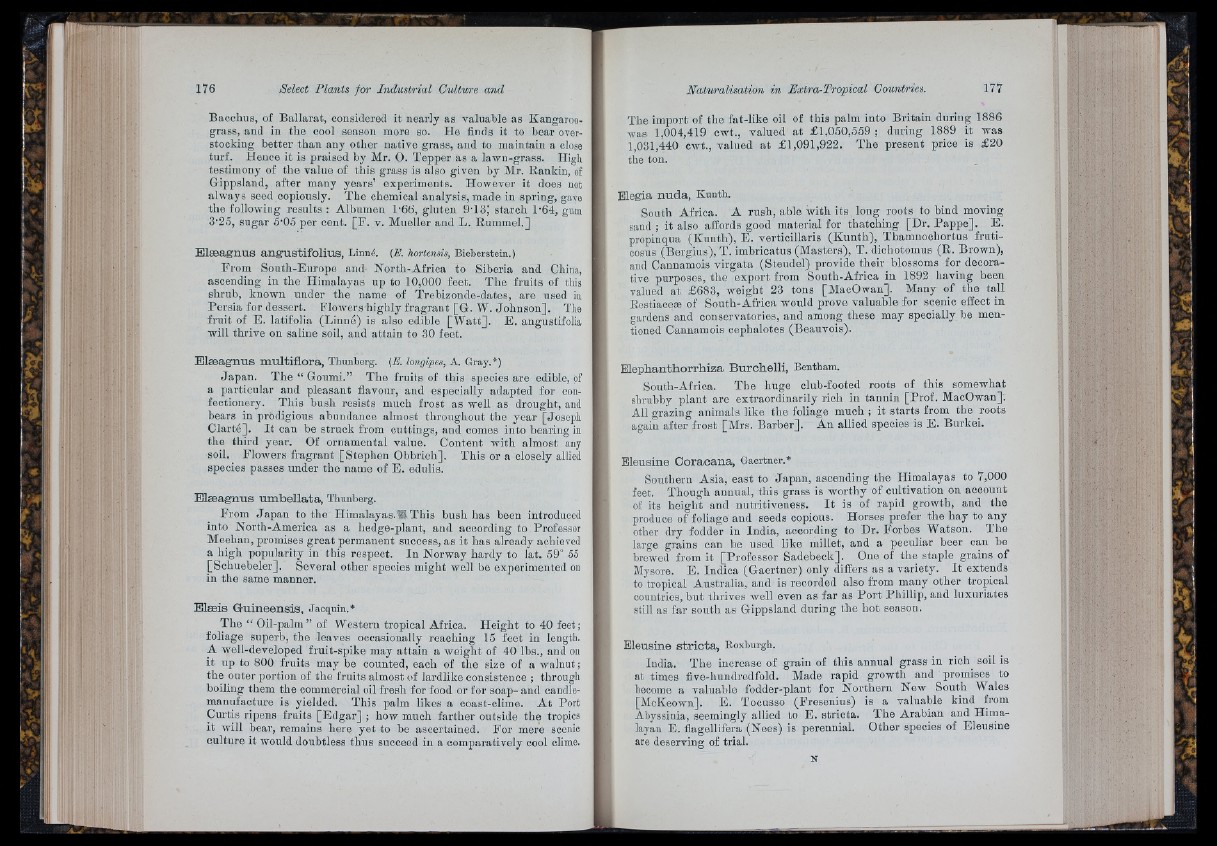
'Ô; 176 Select Plants for Industrial Culture and
Bacchus, of Ballarat, considered it nearly as valuable as Kangaroo-
grass, and in the cool season more so. He finds it to bear overstocking
better than any other native grass, aud to maintain a close
turf. Hence it is praised by Mr. O. Tepper as a lawn-grass. High
testimony of the value of this grass is also given by Mr. Rankin, of
Gippsland, after many years’ experiments. However it does not
always seed copiously. The chemical analysis, made in spring, gave
the following results : Albnmen 1'66, gluten 9T3| starch 1’64, gum
3-25, sugar 5'05 per cent. [F . v. Mueller aud L. Rummel.]
E læ a g n u s a n g u s tifo liu s , Linné. (A hortensia, Bieberstein.)
From South-Europe and- North-Africa to Siberia and China,
ascending in the Himalayas up to 10,000 feet. The fruits of this
shrub, known under the name of Trebizonde-dates, are used in
Persia for dessert. Flowers highly fragrant [G. W. Johnson], The
frnit of E. latifolia (Linné) is also edible [W a tt]. E. angustifolia
will thrive on saline soil, and attain to 30 feet.
E læ a g n u s m u ltiflo ra , Thunberg. (A longipes, A. Gray.*)
Japan. The “ Goumi.” The fruits of this species are edible, of
a particular and pleasant flavour, and especially adapted for confectionery.
This bush resists much frost as well as drought, and
bears in prodigious abundance almost throughout the year [Joseph
Clarté]. I t can be struck from cuttings, aud comes into bearing in
the third year. Of ornamental value. Content with almost any
soil. Flowers fragrant [Stephen Obbrich], This or a closely allied
species passes under the name of E. edulis.
E læ a g n u s um b e lla ta , Thunberg.
From Japan to the Himalayas.8 This bush has been introduced
into North-America as a hedge-plant, and according to Professor
Meehan, promises great permanent success, as it has already achieved
a high popularity in this respect. In Norway hardy to lat. 59° 55
[Schuebeler], Several other species might well be experimented on
in the same manner.
B læ is G u in e e n s is , Jacquin.*
The “ Oil-palm” of Western tropical Africa. Height to 40 feet;
foliage superb, the -leaves occasionally reaching 15 feet in length.
A well-developed fruit-spike may attain a weight of 40 lbs., aud on
it up to 800 fruits may be counted, eacli of the size of a walnut ;
the outer portion of the fruits almost of lardlike consistence ; through
boiling them the commercial oil fresh for food or for soap- and candle-
manufacture is yielded. This palm likes a coast-clime. A t I’ort
Curtis ripens fruits [E d g a r] ; how much farther outside the tropics
it will bear, remains here yet to he ascertained. For mere scenic
culture it would doubtless thus succeed in a comparatively cool clime.
The import of the fat-like oil of this palm into Britain during 1886
was 1,004,419 cwt., valued a t £1,050,559 ; during 1889 it was
1,031,440 cwt., valued a t £1,091,922. The present price is £20
the ton.
Blegia n u d a , Kunth.
South Africa. A rush, able with its long roots to bind moving
sand; it also affords good material for thatching [Dr. Pappe]. E.
propinqua (Knnth), E. verticillaris (Kunth), Thamnochortus fruti-
cosus (Bergius), T. imbricatus (Masters), T. diohotomus (E. Brown),
and Cannamois virgata (Steudel) provide their blossoms for decorative
purposes, the export from South-Africa iu 1892 having been
valued at £683, weight 23 tons [MacOwan]. Many of the tall
Kostiaoece of South-Africa would prove valuable for scenic effect in
gardens and conservatories, and among these may specially be mentioned
Cannamois cephalotes (Beauvois).
B le p h a n th o rrh iz a B u ro h e lli, Bentham.
South-Africa. Tlie huge club-footed roots of this somewhat
shrubby plant are extraordinarily rich in tannin [Prof. MacOwan].
All grazing animals like the foliage much ; it starts from the roots
again after frost [Mrs. Barber]. An allied species is E. Burkei.
Eleusine C o ra c an a , Gaertner.*
Southern Asia, east to Japan, ascending the Himalayas to 7,000
feet. Though annual, this grass is worthy of cultivation on account
of its height and nntritiveness. I t is of rapid growth, and the
produce of foliage and seeds copious. Horses prefer the hay to any
other dry fodder iu India, according to Dr. Forbes Watson. The
large grains can be used like millet, and a peculiar beer can he
brewed from it [Professor Sadebeck]. One of the staple grains of
Mysore. E . Indica (Gaertner) only differs as a variety. I t extends
to tropical Australia, and is recorded also from many other tropical
countries, but thrives well even as far as P o rt Phillip, and luxuriates
still as far south as Gippsland during the hot season.
Eleusine s t r ic ta , Roxburgh.
India. Tlie increase of grain of this annual grass in rich soil is
at times five-hundredfold. Made rapid growth and promises to
become a valuable fodder-plant for Northern New South Wales
[McKeown]. E . Tocusso (Fresenins) is a valuable kind from
Abyssinia, seemingly allied to E. stricta. The Arabian and Himalayan
E. flagellifera (Nees) is perennial. Other species of Eleusine
are deserving of trial.
■fr.